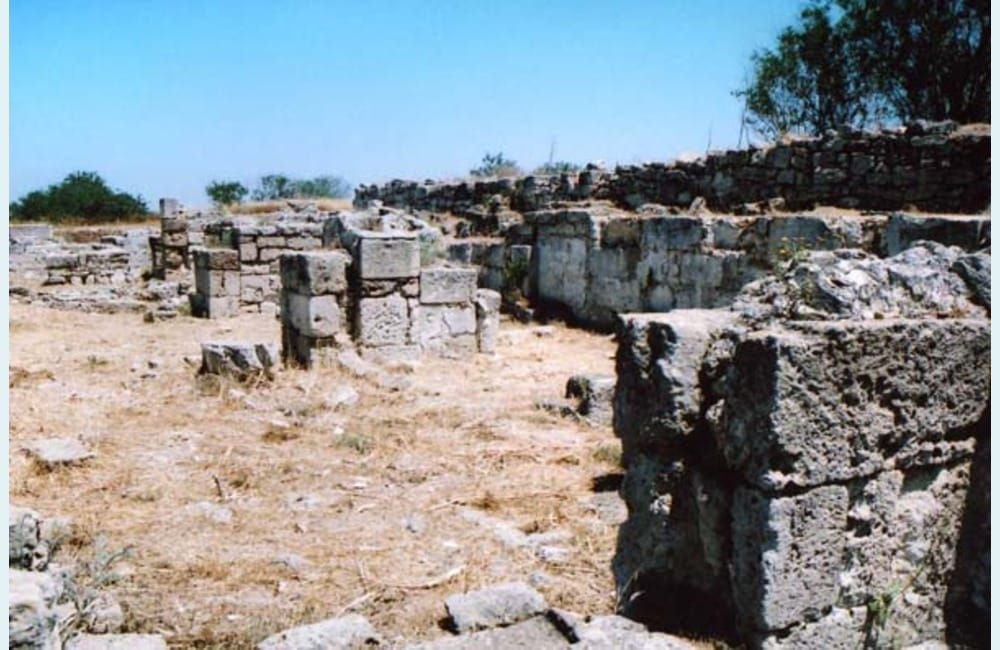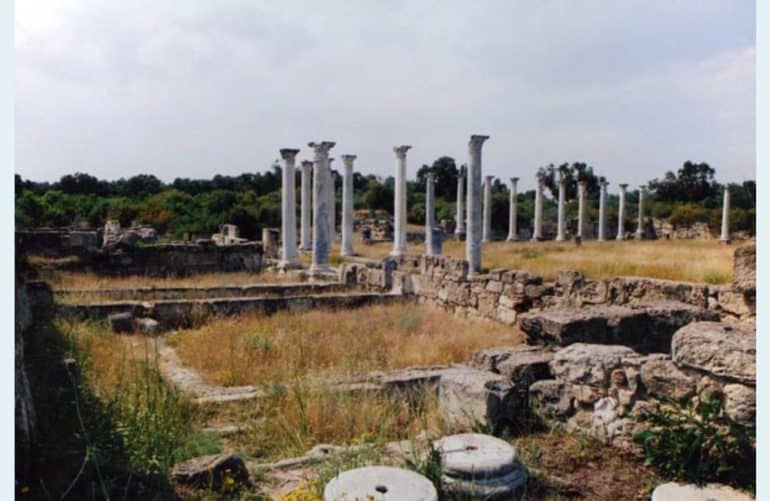One of the most important cities of Cyprus during the Early Byzantine period, also known in the sources as Constantia.
It is the successor city of ancient Salamis, on the east coast of Cyprus, founded after the Trojan War by Teukros Telamonius, according to ancient tradition. Even more correctly, it is about Salamis itself that was rebuilt and took a new name after its destruction due to the terrible earthquakes of 332 and 342 AD.
Salamis, which had also suffered extensive destruction in 116 AD, as a result of the revolt of the Jews who lived there, and had been rebuilt with the help of the Roman emperor Hadrian, faced new bright prospects after the division of the vast Roman empire into Western and Eastern (=Byzantine) Roman state, in 330 AD. However, the beginning of the Byzantine period of Cypriot history is marked by two catastrophic earthquakes, in 332 and 342 AD, which particularly affected Salamis.

The city was then helped financially by the emperor of the Eastern (=Byzantine) Roman state, Constantius, in order to rebuild and recover from the extensive calamity. Among other things, Emperor Constantius exempted the inhabitants of Salamis from tax burdens for four years. So in his honor, for his help and assistance to the stricken city, the inhabitants of Salamis renamed it Constantia.
In the philological sources the city is referred to both as Constantia and as Constantia. Suidas, for example, referring to the (arch)bishop of Cyprus Epiphanius the Great, writes:
Epiphanios, bishop of Constantia of Cyprus, formerly of Salamis...

Hierocles also, in the work of Synekdimos (6th century AD), among the Cypriot cities he lists, first cites Constantia (Honigmann's version) or Constantian metropolis (Burckhardt's version).
The same happens in the work of George of Cyprus Description of the Eastern Roman State (7th century AD).
Again, Constantine Porphyrogenitus, in his book Peri Themata (10th century AD), lists 15 Cypriot cities, the first of which is the metropolis of Constantia.
In the Life of Saint Auxibius, reference is made to the martyrdom of the apostle Barnabas in Salamis, and it is mentioned, among other things, that the apostle, together with the evangelist Mark, having traveled all over the island, came to Salamis, now Constantia...
As Constantia, the city is also mentioned in the Life of Saint Epiphanius and in various other writings that refer to Saint Epiphanius, bishop of Constantia of Cyprus, such as in the Ecclesiastical History of Socrates, in the Life of John Chrysostom by Theodore Bishop Trimithous, in the book Dialogos Historikos... of Palladius, as well as in Minologion where the commemoration of our holy father Epiphanius, Archbishop of Constantia Cyprus is set on May 12.

In the Commentaries on Isocrates again, the city is referred to as the city of Constantine:
...in his Eagoras reigned Salamis, a city in Cyprus, now called Constantine and metropolitan of all Cyprus...
Here it is wrongly and due to a misunderstanding referred to as the city of Constantine, because it had not taken this name from Constantine the Great (like Constantinopolis, the seat of the empire), but from Constantius, the son of Constantine the Great, as mentioned above.
Moreover, Malalas (Chronography, 12.415) refers to the event in the 6th AD. century, which writes the following, in a modern Greek rendering:
...During the reign of [Constantine] Salamis, a city of Cyprus, was struck by an earthquake due to the wrath of God, and the greater part of it was submerged in the sea while the rest was thrown to the ground. This city was rebuilt by Constantius himself, who erected edifices and gave many bounties to the citizens who had survived, to whom he also gave the taxes for four years; and after he had built various edifices in the city formerly called Salamis, he renamed it after of Constantius. This is now the capital of Cyprus…
Salamis/Constantia became, during the Early Byzantine period, the metropolis (i.e. capital) of Cyprus, removing this coveted title from Paphos which had acquired it during the Hellenistic era and had retained it during the following Roman era. The advantages that Paphos gathered during the Hellenistic era, and which had made it the capital of the island, included the basic fact that it was built in that area of the island that was closest to Alexandria in Egypt, the seat of the Ptolemaic kingdom, of which Cyprus was a part. But after the subordination of Cyprus to the Eastern (Byzantine) Roman state (330 AD), this basic fact changed.
As Cyprus had originally (with Diocletian's reforms supplemented by Constantine the Great) been administratively subject to the prefect of the praetorium of the East (praefectus praetorio orientis) based in Antioch, northern and eastern Cyprus were now closer to the important provincial administrative centers of the empire. Of the cities of the island in these areas, only Salamis had such a heavy historical past and so much earlier glamor and splendor that it now claims the title of the Cypriot capital. Perhaps its glorious past was one of the reasons why the immediate imperial interest was shown in the reconstruction of the city after its terrible earthquakes.
The city was rebuilt, now covering a smaller area, but in a short time it was able to reach a level of relative prosperity (relative, because the whole of Cyprus suffered at that time from theomen and disasters of a large area, which were even combined by church tradition with the visit to Cyprus, a few years earlier, of Saint Helen, the mother of Constantine the Great). Thus, despite the disasters, Salamis/Constantia became the administrative and ecclesiastical capital of Cyprus, although there is a reference in the sources that Amathus had also for some time become the seat of Byzantine "dukes", i.e. governors of Cyprus.
Among the first hierarchs of the Cypriot Church who had their headquarters in Constantia, and who for this reason are considered not bishops but archbishops of Cyprus, were Gelasius (or Gerasius), Ophellius, Epiphanius the Great, Riginus, Anthemius, Arkadios I et al. Epiphanios, whom the Church honors as a saint, was a figure not only of pan-Cypriot radiation, but also important within the wider context of the empire, with activity also in this capital, Constantinople.
Constantia, receiving various influences during the first centuries after Christ, had, among other things, become a place where the various Christian sects, against which Saint Epiphanius had fought, had an impact. As it is mentioned in the Life of Saint Epiphanius, there were multitudes in Constantia of this sect [of the Valentinians]...and there were also many other sects in the land of Cyprus, such as the Ophitians, Sabellians, Nicolaitans, Simonians, Basilians, Carpopratians...
Among other things, Epiphanius had convened in Constantia in 401 AD. a synod of Cypriot bishops, following a request from Theophilos of Alexandria, which condemned Origen as a heretic.
The splendor of Constantia is witnessed, among others, by the two large basilicas that have been excavated in the area of ancient Salamis, the basilicas of Agios Epiphanios and Campanopetra. The first is believed to have been that temple which Saint Epiphanius himself had originally erected. For these two basilicas see details in the entries Epiphanio Agios basilica and Campanopetra basilica.
Constantia developed relatively quickly into a large and prosperous city, in which considerable wealth had accumulated. This rapid development is due, to a large extent, to the fact that other devastating earthquakes that followed had mainly affected the southern and southwestern parts of Cyprus and had halted the development of other important cities, such as Kourion and Paphos. The upward course of Constantia, however, was violently interrupted by the Arab raids, in the 7th century, which brought about its almost complete destruction. The city was hit hard already by the first great raid of Moab, in 647 AD. Moabius, emir of Syria, had attacked Cyprus in the spring of that year, with a force numbering 1.700 ships. His first major target was the capital Constantia which was, moreover, the closest city of Cyprus to the Syrian coast. He asked its inhabitants to surrender, and they refused. The Moabian army then laid siege to Constantia, which it eventually captured. Large-scale looting and destruction followed, which proved fatal for the city, and the raiders then only left when they were informed that the arrival of strong Byzantine military forces was imminent. As usual, in addition to the massacres and other atrocities, the raiders took a number of slaves/captives with them when they left. Among the city's buildings that had been set on fire and destroyed was the glorious basilica of Saint Epiphanius.
The inhabitants of Constantia — those who had survived — remained in a half-ruined city which they slowly began to rebuild. But only six years later, in 653 AD, Moab ordered a new major raid of his troops in Cyprus, under the leadership of Abu 'l Avar and with Abdallah ΄ibn Kais as the leader of the fleet (of 500 ships). The already completely weakened Constantia was again the first target of the Arabs. It was now easily captured, again savagely plundered and set on fire, before Abu 'l Avar turned to other parts of the island, as far as Paphos, whence he departed laden with rich booty.
This second attack was also the coup de grace against Constantia. Many of its inhabitants who had survived, left it permanently in search of a permanent residence in safer areas in the interior of the island. The same, moreover, happened with almost all the other coastal settlements (towns and villages) of Cyprus, which were abandoned during the Arab raids between the 7th and 10th centuries.
Constantia could not recover from these two crucial blows. Some life in the half-ruined city continued in the following years, since in 723 AD. we have the testimony of an English pilgrim, Willibald, who passed through both Paphos and Constantia on his way to the Holy Land. Willibald, who stayed three weeks in Paphos and Constantia, writes that he had met in these cities both Greeks and Saracens, who were all unarmed because peace and friendship now prevailed. There is also a version that, however, cannot be proven due to the lack of sufficient written sources, that Constantia was helped during the days of Emperor Justinian II (685-695, 705-711), when the original building of his basilica was also modified Agios Epiphanios, and that at that time the city had been renamed Nea Iustinianopolis. It seems, however, that at the beginning of the 8th AD century, at least the central part of the city had been fortified. However, Justinian II had transported many Cypriots to resettle in the Hellespont, and among those who had left, many inhabitants of Constantia were probably included. The move was not successful and the Cypriots (those who survived) returned to Cyprus in a few years.
In 787 AD we have the testimony of the archbishop of Cyprus (Constantia) Constantinos at the 7th Ecumenical Council, that the city had not ceased to be inhabited, and that at that time several farmers lived in it with their animals. However, a new name for the city, the name Famagusta, will already be widely used, which will eventually prevail. Thus, without the existence of a time gap, Famagusta succeeded Constantia. Because for a period the names Constantia and Famagusta co-exist, we cannot say with certainty when the latter replaced the former.
An important detail must, however, be clarified here: The city of Famagusta is not located in the exact same area as Salamis / Constantia but a little further south, in the area where the city of Arsinoe was built during the Hellenistic years (that is, one of the three cities of Cyprus with this name). Famagusta therefore began to develop when several inhabitants of Constantia fled to it after its destruction by the Arab raids, until gradually Constantia was completely abandoned. That is why, moreover, for a period the two cities coexisted.
With information from Polygnosis encyclopedia
